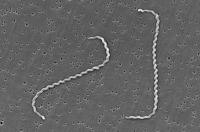
Photo from wikipedia
Rotation of a helical cell body and mobility of cell-surface adhesins result in surface motility of the spirochete Leptospira. Many species of bacteria are motile, but their migration mechanisms are… Click to show full abstract
Rotation of a helical cell body and mobility of cell-surface adhesins result in surface motility of the spirochete Leptospira. Many species of bacteria are motile, but their migration mechanisms are considerably diverse. Whatever mechanism is used, being motile allows bacteria to search for more optimal environments for growth, and motility is a crucial virulence factor for pathogenic species. The spirochete Leptospira, having two flagella in the periplasmic space, swims in liquid but has also been previously shown to crawl over solid surfaces. The present motility assays show that the spirochete movements both in liquid and on surfaces involve a rotation of the helical cell body. Direct observations of cell-surface movement with amino-specific fluorescent dye and antibody-coated microbeads suggest that the spirochete attaches to the surface via mobile, adhesive outer membrane components, and the cell body rotation propels the cell relative to the anchoring points. Our results provide models of how the spirochete switches its motility mode from swimming to crawling.
Journal Title: Science Advances
Year Published: 2018
Link to full text (if available)
Share on Social Media: Sign Up to like & get
recommendations!